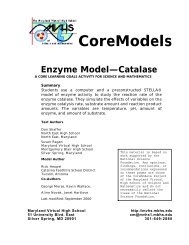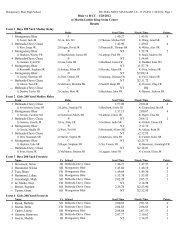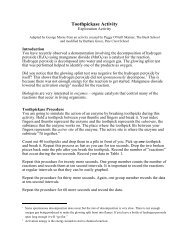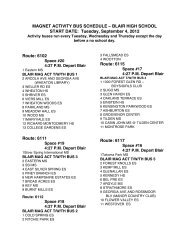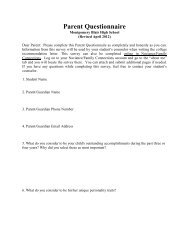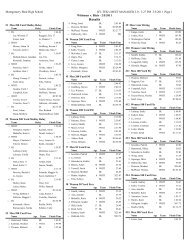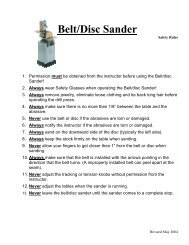The Structure and Function of Enzymes MODULE 1 MODULE 2 ...
The Structure and Function of Enzymes MODULE 1 MODULE 2 ...
The Structure and Function of Enzymes MODULE 1 MODULE 2 ...
Create successful ePaper yourself
Turn your PDF publications into a flip-book with our unique Google optimized e-Paper software.
Silent DemonstrationWhat Affects the <strong>Function</strong> <strong>of</strong> an Enzyme?Module 3 Engagement ActivityDirections for the demonstrationStudents are instructed to take notes, move to where they can see, <strong>and</strong> remain silentduring the demonstration. <strong>The</strong> teacher holds up a pair <strong>of</strong> scissors <strong>and</strong> a piece <strong>of</strong> paper sothat everyone can see them. <strong>The</strong> paper is then cut in half. <strong>The</strong> teacher holds up the twopieces <strong>of</strong> paper (from the first part <strong>of</strong> the demonstration) <strong>and</strong> a stapler. <strong>The</strong> pieces <strong>of</strong>paper are then stapled together. <strong>The</strong> teacher announces that the demonstration is over.Questions posed to students<strong>The</strong> demonstration that you have just seen is an analogy for enzyme action. Name theenzymes, substrates, <strong>and</strong> products <strong>of</strong> the demonstration. [<strong>The</strong> scissors <strong>and</strong> stapler areenzymes; the whole paper <strong>and</strong> pieces <strong>of</strong> paper are substrates for one reaction <strong>and</strong>products <strong>of</strong> another reaction] Note: Inspiration, an overhead, or a chalk board can beused to record the responses. This gives time for students to visualize the answers.What types <strong>of</strong> reactions were observed? [Synthesis <strong>and</strong> decomposition/hydrolysis; thisquestion may be inappropriate if students are not familiar with the content.]Other than enzymes <strong>and</strong> substrates, what was needed for the reactions to occur? [Energywas needed; the teacher supplied this in the demonstration.]What would alter or prevent the reactions from occurring? [Lack <strong>of</strong> energy, change in theshape <strong>of</strong> the enzyme – dull or damaged scissors, no staples in the stapler.] <strong>The</strong> teacherguides the students to these answers during the summary if they are not established here.Shape-fitting toys can be used to emphasize the importance <strong>of</strong> shape.SummaryEnergy is necessary for reactions to occur. <strong>The</strong> amount <strong>of</strong> energy needed is called theactivation energy. <strong>Enzymes</strong> work by lowering the activation energy needed for areaction. <strong>The</strong> shape <strong>of</strong> an enzyme is critical to accomplishing this. If sufficient energy isnot available, the reaction does not occur. This is why we refrigerate or freeze foods.<strong>Enzymes</strong> are made <strong>of</strong> protein <strong>and</strong> proteins can be denatured. That is, temperature, pH,salinity, or other environmental factors may change the shape <strong>of</strong> the molecule.Teacher noteThis leads into <strong>The</strong> Effects <strong>of</strong> pH on the <strong>Function</strong> <strong>of</strong> Catalase laboratory investigation(Exploration Activity).24





